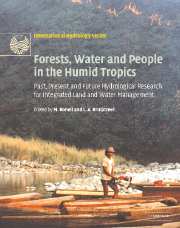 Forests, Water and People in the Humid Tropics
Forests, Water and People in the Humid Tropics Book contents
- Frontmatter
- Contents
- List of contributors
- Foreword
- Preface
- Acknowledgements
- Symposium and Workshop
- Introduction
- Part I Current trends and perspectives on people–land use–water issues
- Part II Hydrological processes in undisturbed forests
- Part III Forest disturbance, conversion and recovery
- Part IV New methods for evaluating effects of land-use change
- Part V Critical appraisals of best management practices
- 35 Guidelines for controlling vegetation, soil and water impacts of timber harvesting in the humid tropics
- 36 Minimising the hydrological impact of forest harvesting in Malaysia's rainforests
- 37 Red flags of warning in land clearing
- 38 From nature to nurture: soil and water management for rainfed steeplands in the humid tropics
- Conclusion: Forests, water and people in the humid tropics: an emerging view
- Plate section
- References
37 - Red flags of warning in land clearing
from Part V - Critical appraisals of best management practices
Published online by Cambridge University Press: 12 January 2010
- Frontmatter
- Contents
- List of contributors
- Foreword
- Preface
- Acknowledgements
- Symposium and Workshop
- Introduction
- Part I Current trends and perspectives on people–land use–water issues
- Part II Hydrological processes in undisturbed forests
- Part III Forest disturbance, conversion and recovery
- Part IV New methods for evaluating effects of land-use change
- Part V Critical appraisals of best management practices
- 35 Guidelines for controlling vegetation, soil and water impacts of timber harvesting in the humid tropics
- 36 Minimising the hydrological impact of forest harvesting in Malaysia's rainforests
- 37 Red flags of warning in land clearing
- 38 From nature to nurture: soil and water management for rainfed steeplands in the humid tropics
- Conclusion: Forests, water and people in the humid tropics: an emerging view
- Plate section
- References
Summary
INTRODUCTION
Land clearance in the humid tropics needs to be considered very carefully. This chapter is an attempt to put the brakes on, or at least to insert a filter of conditions, so that any clearing does not have adverse, or only minimally adverse, effects on soil and water resources and processes. It follows on from the many precautionary statements, some even labelled ‘guidelines’ that have appeared since the early 1970s. As a matter of forest land policy, setting the framework for planning, there should be a thorough examination of alternatives to clearing more land. Poore and Sayer (1987) put it succinctly:
‘Before deciding to modify or transform untouched areas, every consideration should be given to alternatives. This may include adapting areas that have already been changed, to more productive uses, for example, using savannas for pine plantations. Alternatively, it may involve intensification of existing uses, or using areas for more than one purpose, if these are compatible.’
The high cost (in both ecological and economic terms) of any new land development dictates that the starting point in planning should be a detailed analysis of alternatives including possibilities of intensification on land already converted (Hansen and Dickensen, 1987). Similarly, there is an early need for an assessment of the capability and suitability of an area under planning scrutiny for the proposed use if alternatives are not available. Such an assessment, using well-developed procedures (e.g. Carpenter, 1981; FAO, 1974), if rigorously carried out may abort a proposed conversion.
- Type
- Chapter
- Information
- Forests, Water and People in the Humid TropicsPast, Present and Future Hydrological Research for Integrated Land and Water Management, pp. 866 - 880Publisher: Cambridge University PressPrint publication year: 2005
References
- 3
- Cited by


